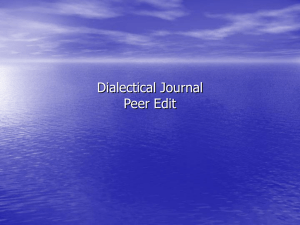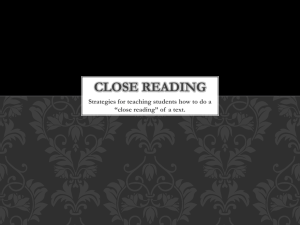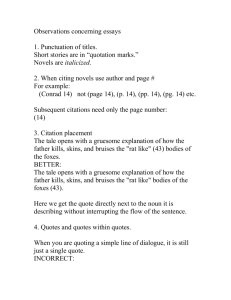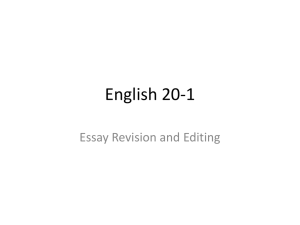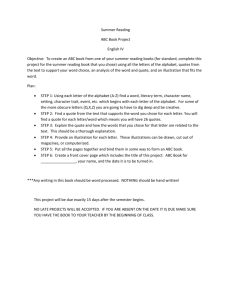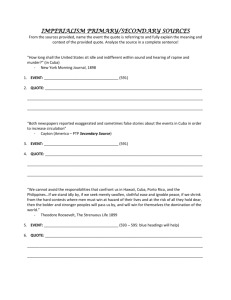Directions
advertisement
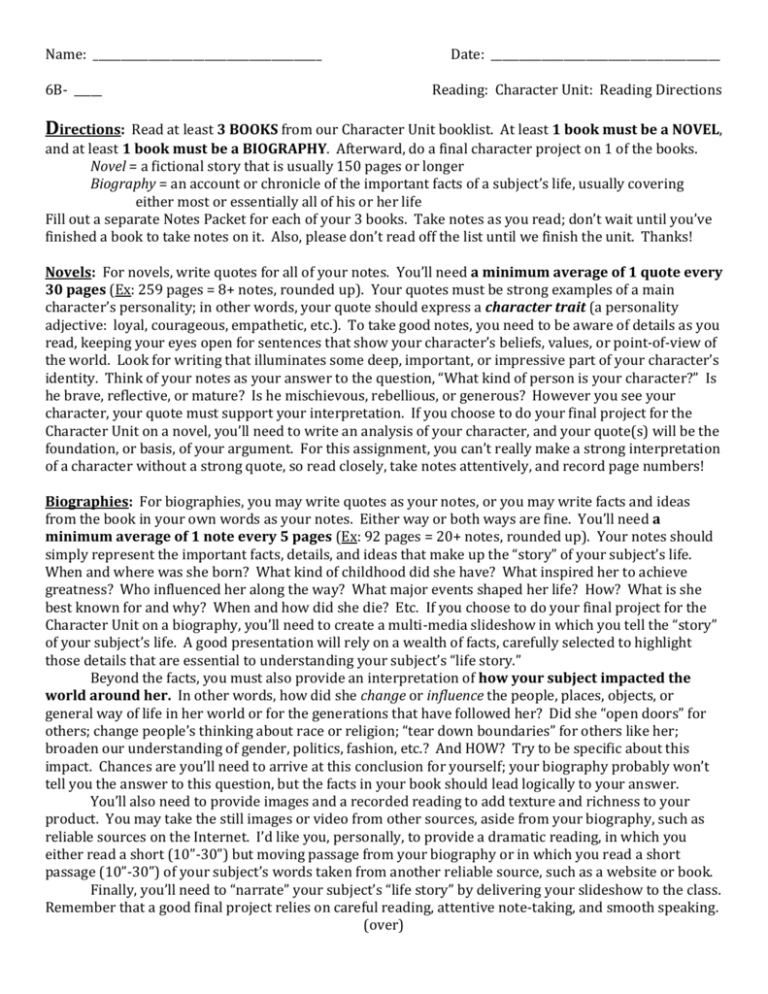
Name: _________________________________________ 6B- _____ Date: _________________________________________ Reading: Character Unit: Reading Directions Directions: Read at least 3 BOOKS from our Character Unit booklist. At least 1 book must be a NOVEL, and at least 1 book must be a BIOGRAPHY. Afterward, do a final character project on 1 of the books. Novel = a fictional story that is usually 150 pages or longer Biography = an account or chronicle of the important facts of a subject’s life, usually covering either most or essentially all of his or her life Fill out a separate Notes Packet for each of your 3 books. Take notes as you read; don’t wait until you’ve finished a book to take notes on it. Also, please don’t read off the list until we finish the unit. Thanks! Novels: For novels, write quotes for all of your notes. You’ll need a minimum average of 1 quote every 30 pages (Ex: 259 pages = 8+ notes, rounded up). Your quotes must be strong examples of a main character’s personality; in other words, your quote should express a character trait (a personality adjective: loyal, courageous, empathetic, etc.). To take good notes, you need to be aware of details as you read, keeping your eyes open for sentences that show your character’s beliefs, values, or point-of-view of the world. Look for writing that illuminates some deep, important, or impressive part of your character’s identity. Think of your notes as your answer to the question, “What kind of person is your character?” Is he brave, reflective, or mature? Is he mischievous, rebellious, or generous? However you see your character, your quote must support your interpretation. If you choose to do your final project for the Character Unit on a novel, you’ll need to write an analysis of your character, and your quote(s) will be the foundation, or basis, of your argument. For this assignment, you can’t really make a strong interpretation of a character without a strong quote, so read closely, take notes attentively, and record page numbers! Biographies: For biographies, you may write quotes as your notes, or you may write facts and ideas from the book in your own words as your notes. Either way or both ways are fine. You’ll need a minimum average of 1 note every 5 pages (Ex: 92 pages = 20+ notes, rounded up). Your notes should simply represent the important facts, details, and ideas that make up the “story” of your subject’s life. When and where was she born? What kind of childhood did she have? What inspired her to achieve greatness? Who influenced her along the way? What major events shaped her life? How? What is she best known for and why? When and how did she die? Etc. If you choose to do your final project for the Character Unit on a biography, you’ll need to create a multi-media slideshow in which you tell the “story” of your subject’s life. A good presentation will rely on a wealth of facts, carefully selected to highlight those details that are essential to understanding your subject’s “life story.” Beyond the facts, you must also provide an interpretation of how your subject impacted the world around her. In other words, how did she change or influence the people, places, objects, or general way of life in her world or for the generations that have followed her? Did she “open doors” for others; change people’s thinking about race or religion; “tear down boundaries” for others like her; broaden our understanding of gender, politics, fashion, etc.? And HOW? Try to be specific about this impact. Chances are you’ll need to arrive at this conclusion for yourself; your biography probably won’t tell you the answer to this question, but the facts in your book should lead logically to your answer. You’ll also need to provide images and a recorded reading to add texture and richness to your product. You may take the still images or video from other sources, aside from your biography, such as reliable sources on the Internet. I’d like you, personally, to provide a dramatic reading, in which you either read a short (10”-30”) but moving passage from your biography or in which you read a short passage (10”-30”) of your subject’s words taken from another reliable source, such as a website or book. Finally, you’ll need to “narrate” your subject’s “life story” by delivering your slideshow to the class. Remember that a good final project relies on careful reading, attentive note-taking, and smooth speaking. (over) Tentative DUE DATE for Book #1 NOTE PACKET: ________________________________________ Tentative DUE DATE for Book #2 NOTE PACKET: ________________________________________ Tentative DUE DATE for Book #3 NOTE PACKET: ________________________________________ *You may submit notes early if you’d like to do so… *Please bring your character book to class every day. Final Character Project DUE DATE: When we’re finished with the readings, I’ll provide you with about 2 weeks to complete your final project; the specific due date is TBD... I’ll also provide you with more specific guidelines for the projects at that point. Quotes: A quote, or quotation (noun), is writing that someone has copied, word-for-word, from another source, often to make a point. To quote (verb) is to copy, word-for-word, from another source. You may not change words in a quote, but you may skip words with an ellipsis (…), provided that you don’t change the overall meaning of the quote. You may quote dialogue or narration, meaning you may quote any writing, not just writing that already appears in quotation marks. In other words, you don’t need to quote examples of characters speaking aloud or of pre-existing quotations in your book, which would be hard to find. Look for deeply revealing quotes; avoid quoting first impressions, moods, temporary (passing) moments, and unimportant events. Good quotes will SHOW; they don’t simply tell. In other words, good quotes suggest a character trait; they don’t just name a character trait without also acting as an example of it. Basically, they allow readers to make an inference, or to interpret a meaning, of the wording. You’ll probably need to figure out what a good quote means. In fact, good quotes usually REQUIRE this kind of interpretation. Their meaning does not always seem obvious at first glance. Strong quotes often sound poetic, or special, and always have deep, meaningful ideas written in unique terms that are worth preserving in their original wording. We tend to quote writing that would lose meaning if we put it in our own words. Put another way, a good quote will often appear in a scene when a character takes a minute to put his or her feelings into careful words that show understanding or get beneath the surface of things. To find good character quotes, consider the following: *See Character Keynote notes… 1. DAFT: what the character says (Dialogue), does (Action), feels (Feelings), and thinks (Thoughts) 2. Others’ DAFT: other characters’ reactions to your character 3. Personal Facts / Looks: the personal facts (age, ethnicity, birth order, etc.) and physical looks of your subject, though these tend not to be the strongest, most reliable forms of characterization
